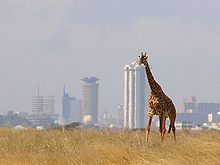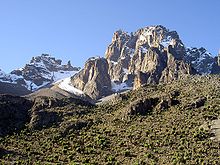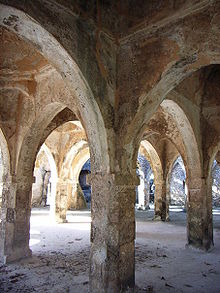| About Kenya |
|
|
| |
| Kenya officially the Republic of Kenya, is a sovereign state in East Africa. Its capital and largest city is Nairobi. Kenya lies on the equator with the Indian Ocean to the south-east, Tanzania to the south, Uganda to the west, South Sudan to the north-west, Ethiopia to the north and Somalia to the north-east. Kenya covers 581,309 km2 (224,445 sq mi) and has a population of about 44 million in July 2012.[6] The country is named after Mount Kenya, the second highest mountain in Africa.
Mount Kenya was originally referred to as "Mt. Kirinyaga" by the indigenous people. "Kirinyaga or Kerenyaga, meaning ‘mountain of whiteness’ because of its snow capped peak"; The name was subsequently changed to Mt. Kenya because of the inability of the British to pronounce "Kirinyaga" correctly.[7]
The country has a warm and humid climate along its Indian Ocean coastline, with wildlife-rich savannah grasslands inland towards the capital. Nairobi has a cool climate that gets colder approaching Mount Kenya, which has three permanently snow-capped peaks. Further inland there is a warm and humid climate around Lake Victoria, and temperate forested and hilly areas in the western region. The northeastern regions along the border with Somalia and Ethiopia are arid and semi-arid areas with near-desert landscapes. Lake Victoria, the world's second largest fresh-water lake and the world's largest tropical lake, is situated to the southwest and is shared with Uganda and Tanzania. Kenya is famous for its safaris and diverse wildlife reserves and national parks such as the East and West Tsavo National Park, the Maasai Mara, Lake Nakuru National Park, and Aberdares National Park. There are several world heritage sites such as Lamu, and world renowned beaches such as Kilifi where international yachting competitions are held each year. |
 |
|
| |
Geography and climate
At 580,367 km2 (224,081 sq mi),[6] Kenya is the world's forty-seventh largest country (after Madagascar). It lies between latitudes 5°N and 5°S, and longitudes 34° and 42°E. From the coast on the Indian Ocean, the low plains rise to central highlands. The highlands are bisected by the Great Rift Valley; a fertile plateau lies in the east. The Kenyan Highlands comprise one of the most successful agricultural production regions in Africa. The highlands are the site of the highest point in Kenya and the second highest peak on the continent: Mount Kenya, which reaches 5,199 m (17,057 ft) and is the site of glaciers. Mount Kilimanjaro (5,895 m or 19,341 ft) can be seen from Kenya to the South of the Tanzanian border.[15]
Kenya's climate varies from tropical along the coast to temperate inland to arid in the north and northeast parts of the country. The area receives a great deal of sunshine every month, and summer clothes are worn throughout the year. It is usually cool at night and early in the morning inland at higher elevations. The "long rains" season occurs from March/April to May/June. The "short rains" season occurs from October to November/December. The rainfall is sometimes heavy and often falls in the afternoons and evenings. The temperature remains high throughout these months of tropical rain. The hottest period is February and March, leading into the season of the long rains, and the coldest is in July and August. |
 |
|
| |
History
Giant crocodile fossils have been discovered in Kenya, dating from the Mesozoic Era, over 200 million years ago. The fossils were found in an excavation conducted by a team from the University of Utah and the National Museums of Kenya in July–August 2004 at Lokitaung Gorge, near Lake Turkana.[17]
Fossils found in East Africa suggest that primates roamed the area more than 20 million years ago. Recent finds near Kenya's Lake Turkana indicate that hominids such as Homo habilis (1.8 and 2.5 million years ago) and Homo erectus (1.8 million to 350 000 years ago) are possible direct ancestors of modern Homo sapiens and lived in Kenya during the Pleistocene epoch. During excavations at Lake Turkana in 1984, palaeoanthropologist Richard Leakey assisted by Kamoya Kimeu discovered the Turkana boy, a 1.6-million-year-old fossil belonging to Homo erectus. Previous research on early hominids is particularly identified with Mary Leakey and Louis Leakey, who were responsible for the preliminary archaeological research at Olorgesailie and Hyrax Hill. Later work at the former site was undertaken by Glynn Isaac.[18]
Kenya has been inhabited by people for as long as human history has existed.
The first inhabitants of present-day Kenya were hunter-gatherer groups, akin to the modern Khoisan speakers.[19] These people were later replaced by agropastoralist Cushitic speakers from the Horn of Africa.[20] During the early Holocene, the regional climate shifted from dry to wetter climatic conditions, providing an opportunity for the development of cultural traditions, such as agriculture and herding, in a more favourable environment.[19]
Around 500 BC, Nilotic speaking pastoralists (ancestral to Kenya's Nilotic speakers) started migrating from present-day Southern Sudan into Kenya.[21][22][23] Nilotic groups in Kenya include the Samburu, Luo, Turkana, Maasai.[24]
By the first millennium AD, Bantu-speaking farmers moved into the region.[25] The Bantus originated in West Africa along the Benue River in what is now eastern Nigeria and western Cameroon.[26] The Bantu migration brought new developments in agriculture and iron working to the region.[26] Bantu groups in Kenya include the Kikuyu, Luhya, Kamba, Kisii, Ameru, Aembu, Ambeere, Wadawida-Watuweta, Wapokomo and Mijikenda among others.
Remarkable prehistoric sites in the interior of Kenya include the archaeoastronomical site Namoratunga on the west side of Lake Turkana and the walled settlement of ThimLich Ohinga in Nyanza Province. |
 |
|
| |
| See more |
| |
|
|
|
| Sponsors & Supporters |
|
|
|
|
| Media Partners |
|
|
|
|
| Int’l Conferences |
|
|
|
|